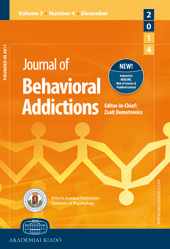Tendencies toward Internet-pornography-use disorder: Differences in men and women regarding attentional biases to pornographic stimuli
Tendencies toward Internet-pornography-use disorder: Differences in men and women regarding attentional biases to pornographic stimuli
Author(s): Jaro Pekal, Christian Laier, Jan Snagowski, Rudolf Stark, Matthias BrandSubject(s): Gender Studies, Behaviorism
Published by: Akadémiai Kiadó
Keywords: Internet-pornography-use disorder; attentional bias; addiction
Summary/Abstract: Background and aims. Several authors consider Internet-pornography-use disorder (IPD) as addictive disorder. One of the mechanisms that has been intensively studied in substance- and non-substance-use disorders is an enhanced attentional bias toward addiction-related cues. Attentional biases are described as cognitive processes of individual’s perception affected by the addiction-related cues caused by the conditioned incentive salience of the cue itself. It is assumed in the I-PACE model that in individuals prone to develop IPD symptoms implicit cognitions as well as cue-reactivity and craving arise and increase within the addiction process. Methods. To investigate the role of attentional biases in the development of IPD, we investigated a sample of 174 male and female participants. Attentional bias was measured with the Visual Probe Task, in which participants had to react on arrows appearing after pornographic or neutral pictures. In addition, participants had to indicate their sexual arousal induced by pornographic pictures. Furthermore, tendencies toward IPD were measured using the short-Internetsex Addiction Test. Results. The results of this study showed a relationship between attentional bias and symptom severity of IPD partially mediated by indicators for cue-reactivity and craving. While men and women generally differ in reaction times due to pornographic pictures, a moderated regression analysis revealed that attentional biases occur independently of sex in the context of IPD symptoms. Discussion. The results support theoretical assumptions of the I-PACE model regarding the incentive salience of addiction-related cues and are consistent with studies addressing cue-reactivity and craving in substance-use disorders.
Journal: Journal of Behavioral Addictions
- Issue Year: 7/2018
- Issue No: 3
- Page Range: 574-583
- Page Count: 10
- Language: English

